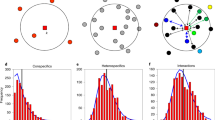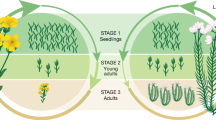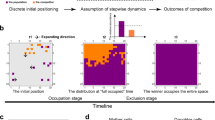Abstract
ECOLOGICAL competition theory has reached its fullest state of development for the special case of competition for a renewable resource1,2. There are, however, many instances of competition in nature to which this theory does not apply; for example, competition for space (Lebensraum). Because there are many space-limited organisms in nature, including many primary producers, this is an important gap in our theoretical understanding of ecological communities. Moreover, since the fundamental dynamic of competition for space—spatial mobility—is quite different from that of competition for a renewable resource, it would be unwise to try to extrapolate the theory of resource limitation to space-limited communities. In this paper, I outline some calculations, in the spirit of refs 3–7, which bear on the relation between stability and diversity for space-limited communities. (Full details will appear elsewhere.)
This is a preview of subscription content, access via your institution
Access options
Subscribe to this journal
Receive 51 print issues and online access
$199.00 per year
only $3.90 per issue
Buy this article
- Purchase on Springer Link
- Instant access to full article PDF
Prices may be subject to local taxes which are calculated during checkout
Similar content being viewed by others
References
MacArthur, R. H., Geographical Ecology (Harper and Row, New York, 1972).
May, R. M., Stability and Complexity in Model Ecosystems (Princeton University Press, Princeton, 1975).
Cohen, J. E., Am. Nat., 104, 547–559 (1970).
Levins, R., and Culver, D., Proc. natn. Acad. Sci. U.S.A., 68, 1246–1248 (1971).
Horn, H., and MacArthur, R. H., Ecology, 53, 749–752 (1972).
Levin, S. A., Am. Nat., 108, 207–228 (1974); Lectures on Mathematics in the life Sciences, 8 (edit. by Levin, S. A.), 1–35 (American Mathematical Society, Providence, 1976).
Levin, S. A., and Paine, R. T., Proc. natn. Acad. Sci. U.S.A., 71, 2744–2747 (1974).
Skellam, J. G., Biometrika, 38, 196–218 (1951).
Othmer, H. G., and Scriven, L. E., J. theor. Biol., 32, 507–537 (1971).
May, R. M., Am. Nat., 107, 621–650 (1973).
Author information
Authors and Affiliations
Rights and permissions
About this article
Cite this article
YODZIS, P. Species richness and stability of space-limited communities. Nature 264, 540–541 (1976). https://doi.org/10.1038/264540a0
Received:
Accepted:
Published:
Issue Date:
DOI: https://doi.org/10.1038/264540a0
This article is cited by
-
Exploring co-extinction correlates: the effects of habitat, biogeography and anthropogenic factors on ground squirrels–dung beetles associations
Biodiversity and Conservation (2011)
Comments
By submitting a comment you agree to abide by our Terms and Community Guidelines. If you find something abusive or that does not comply with our terms or guidelines please flag it as inappropriate.



